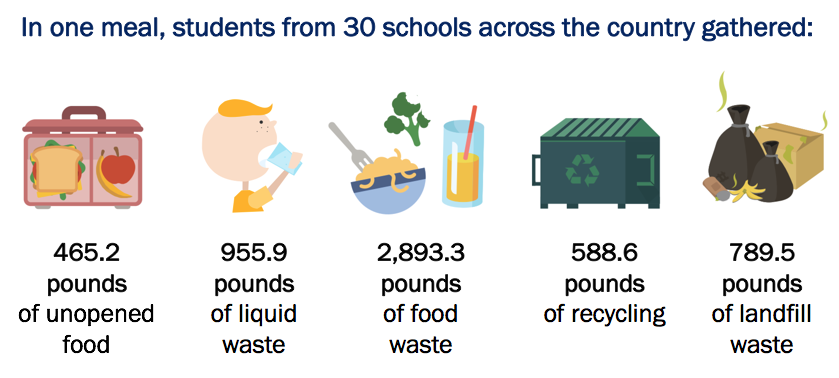High school students shocked at waste uncovered during cafeteria food waste audits – National Consumers League
 “Schools are a place of learning. The cafeteria should be too!”
“Schools are a place of learning. The cafeteria should be too!”
I’m willing to guess that if you ask almost any student their favorite school period, the resounding answer will be “lunch!” My memories of school lunch involve scarfing down a peanut butter sandwich and quickly catching up with friends before our 30 minutes were up. The cafeteria is hectic, lines are long, and many students rush through their meals in order to preserve time to socialize. So too often, a hasty lunch period leaves trash bins overflowing with half-eaten sandwiches and other barely touched food items.
Food waste in American schools is a major problem. Studies have found that U.S. schools waste a total of about $1.2 billion annually. There are many theories as to why schools produce so much food waste, but in order to really identify the root causes, we have to get our hands dirty. And who better to dig into a messy issue than energetic high school students?
In the spring of 2017, students participating in LifeSmarts, NCL’s signature consumer literacy program, were given the unique challenge of conducting a food waste audit in their school cafeterias. Throughout the 2016–2017 academic year, LifeSmarts students studied the impacts of food waste that infiltrate almost every aspect of consumers’ lives. Students learned about the humanitarian and environmental impact of food waste. Having this background knowledge helped the students contextualize the auditing challenge within the discourse of the national and global food waste problem.
The terms of the challenge required students to conduct one audit in their cafeteria during one lunch period. Students worked with their peers to separate waste into five separate bins: unopened food, organic waste, liquid waste, recycling, and landfill waste. Students recorded the weight of each bin and answered a series of data-related and critical thinking questions, which gave them an opportunity to connect their real-life results with the national and global impacts of food waste.
Students’ reactions were diverse, and their suggestions inform insightful structural and policy solutions for preventing and reducing food waste in schools and communities.
One student shared:
“Before the food audit, we predicted that the amount of food wasted would peak at around 70 percent of the total weight of food received, however when we combined the total weight of food thrown away and the unserved cafeteria food we were astonished to find that the true amount of food wasted was around 85 percent.“
Some students went an extra step to try to understand why food was being thrown out:
“Additionally, we were interested in evaluating the variety, amount, and nutrition within the available choices and determine how healthy students are eating at our school. This data will be shared with the food distributer for our high school as well as the School Committee.”
Students were also confronted with limitations from their school board:
“Unopened food cannot be shared, saved, or removed from the school per BOE directives.”
“Prepared cafeteria foods that were untouched had to be disposed of as food waste.”
As students became aware of the issue, they presented next steps for increasing efforts to reduce waste:
“Our LifeSmarts Team could encourage the administration to make a student lunch advisory board to review the lunches and see which meals students are reluctant to consume.”
One of the most striking findings from the audit challenge is the combined metrics of waste generated.
 Instead of throwing away unopened food, it could have been recovered or donated. The potential for food rescue is detailed in the table below. Amounts were calculated using Food Rescue’s conversion tool.
Instead of throwing away unopened food, it could have been recovered or donated. The potential for food rescue is detailed in the table below. Amounts were calculated using Food Rescue’s conversion tool.
| Items rescued | 2,444 | |
| Meals rescued | 488 | |
| Pounds of CO2e rescued (the amount of carbon dioxide which would have the equivalent global warming impact) | 305.5 |
The feedback from students who completed this challenge demonstrates the value in conducting food waste audits. Many students expressed interest in conducting more audits to dig deeper into the issue. Others were energized to move forward with engaging community members and school administrators to experiment with new solutions.
In the 2017–2018 academic year, LifeSmarts students will build on the momentum from the first audit challenge and test strategies for reducing waste in their cafeterias. Students will be encouraged to run longer audits, implement solutions, and conduct a second series of audits to measure their success. By collaborating with school administrators, food service workers, and community partners, students will navigate our complex food system, providing opportunities for solution-making from the ground up.















